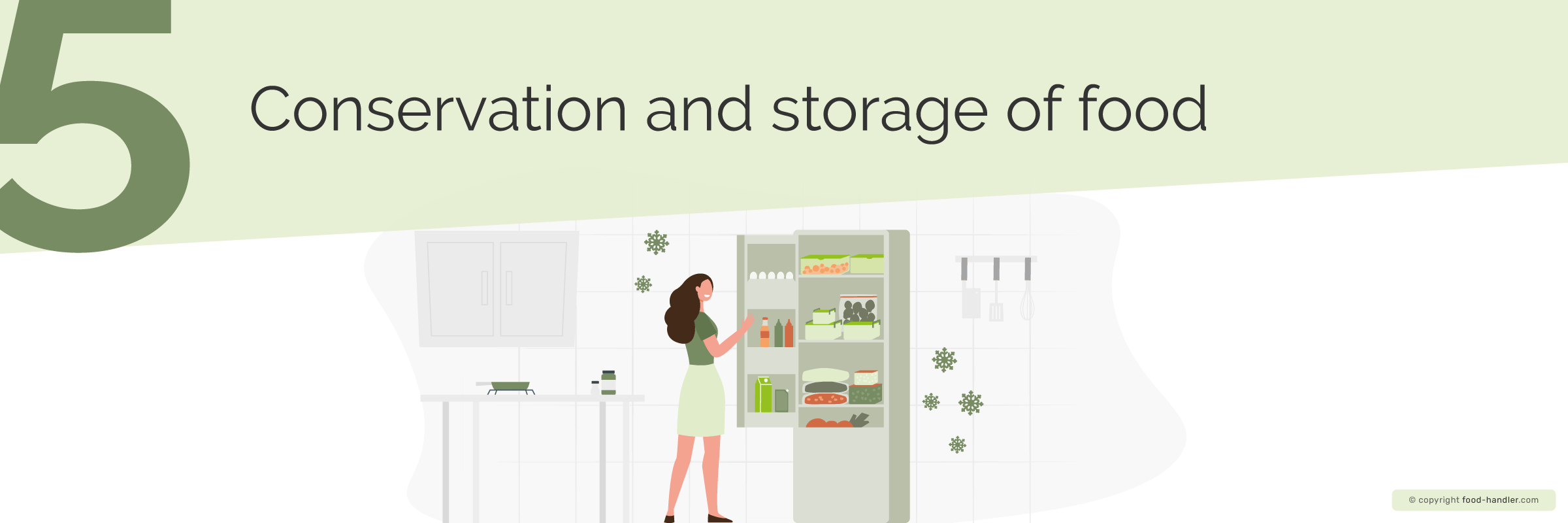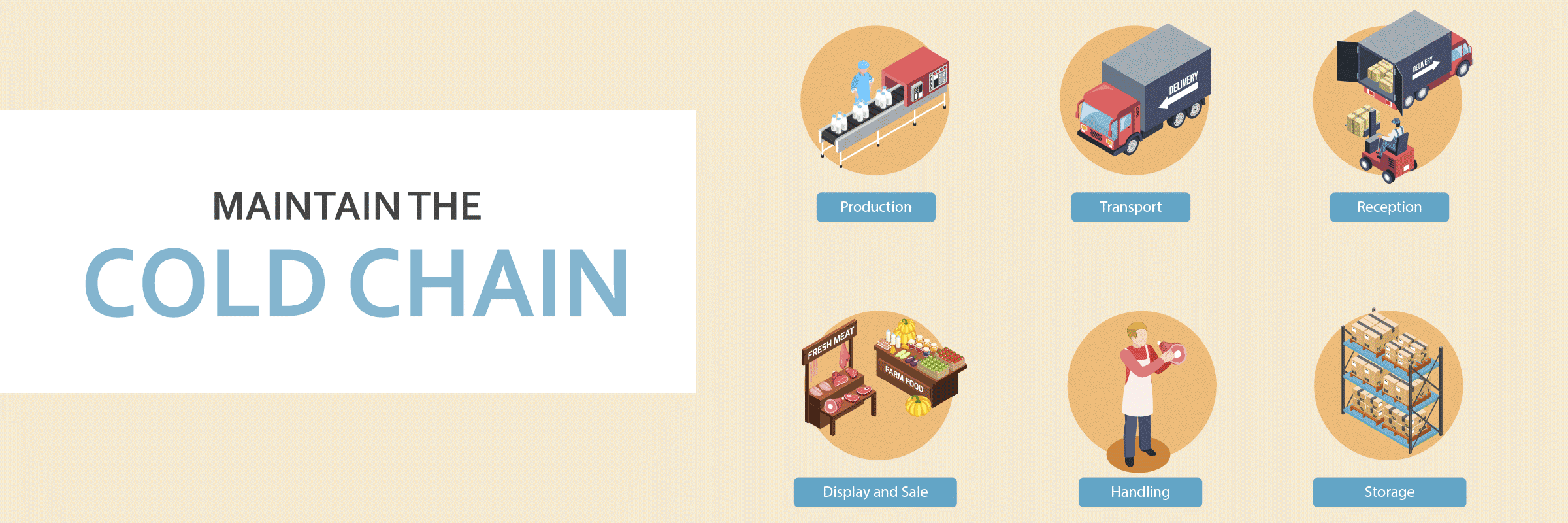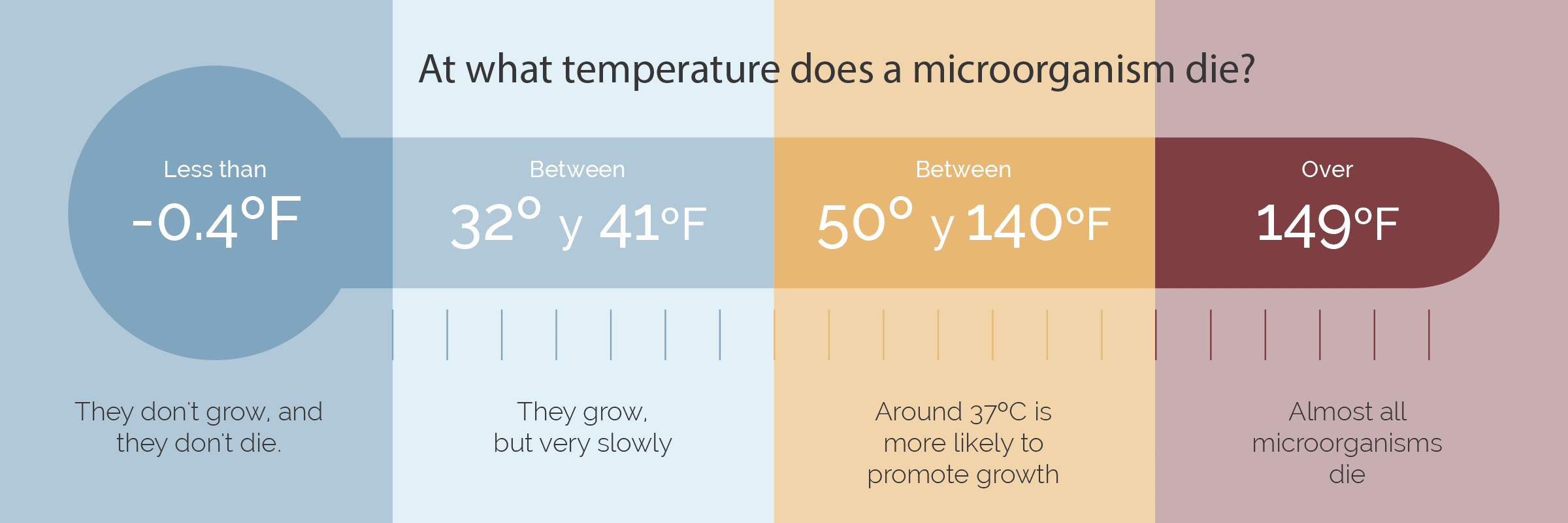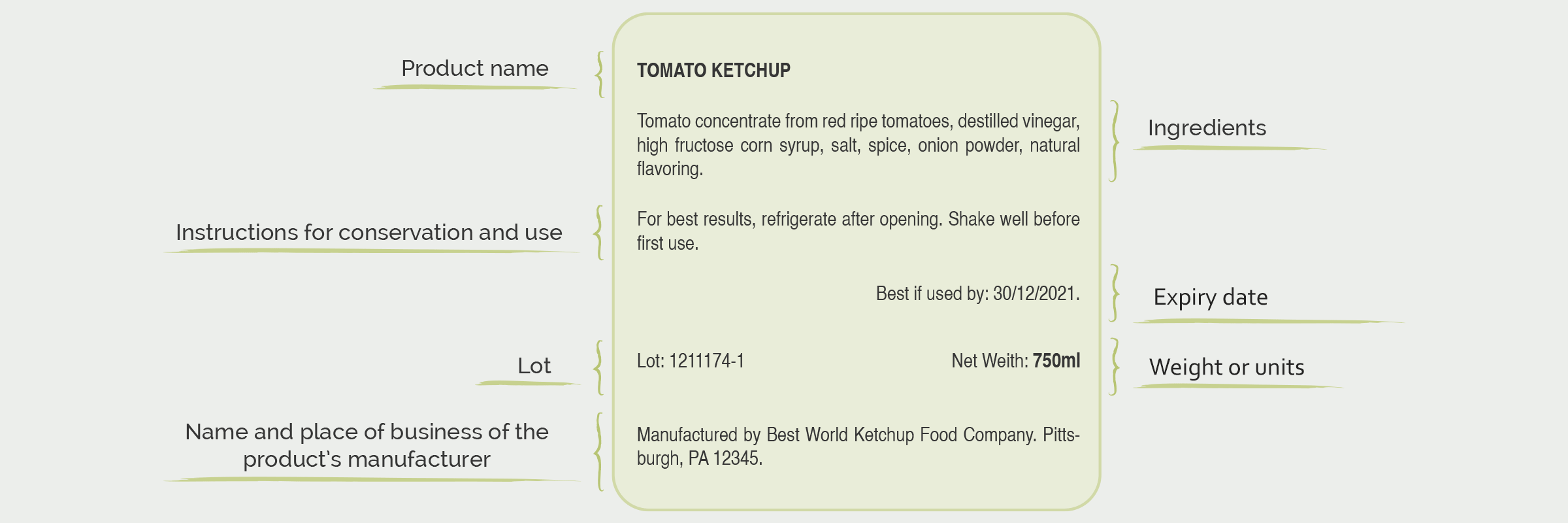Lesson 5: summary

The maximum time a food retains all its organoleptic, nutritional and health properties is called shelf life. The most frequent and traditional conservation systems used are:
- By cooling: refrigeration (Between 0º and 5ºC), freezing (less than -18ºC). The COLD CHAIN (or cool chain) must be maintained always. It consists of maintaining the cold (refrigeration or freezing) throughout the entire process through which the food passes: production, transport, reception, storage, sale to the consumer. If the correct temperature is not maintained during the whole process, the food will suffer IRREVERSIBLE consequences.
- By heating: microorganisms are destroyed by heat. The most popular methods are: pasteurization, cooking, sterilization and ultra-pasteurization.
- Removing part of the water from the food: drying, salting, curing, sugaring, smoking.
- Others: pickling, use of preservatives.

PACKAGING AND LABELLING
Packaging, in addition to protecting the food, also has the function of facilitating distribution and use (dosing). The labels of the products must inform us of everything related to the food it contains, and must contain certain mandatory information:
- Denomination (the name).
- Ingredients.
- Alcoholic strength (if it has one).
- Weight or units
- Instructions for care and use.
- Expiration or shelf life expiration date.
- Company name or name of manufacturer or packager and its address.
- Lot (code with which we can «track» that product in case of problems with it). These are products that are manufactured or packaged under similar circumstances.
The lot is very important, because it is related to the traceability of a product. By traceability we mean the ability to trace or reconstruct the life of a food from its origin to its sale to the final consumer.
Lesson 5: extended
Conservation and storage of food
Types of food preservation
Preserving food consists of preventing the action of contaminating agents that can contaminate it and alter its original characteristics (smell, taste, appearance).

Refrigerated storage
- Refrigeration: consists of keeping the food at low temperatures without it freezing (0 - 5 ºC). At this temperature the microorganisms will multiply very slowly.
- Freezing: consists in subjecting the food to temperatures below the freezing point for a reduced time (18ºC or less). This process causes some of the water in the food to become ice, so that the microorganisms that exist prior to freezing do not grow, but neither do they die. In this process, it is important that freezing takes place in the shortest possible time so that the original characteristics of the product are not affected.
- Ultrafreezing: consists of subjecting the food to a temperature of between -35 and -150 ºC, again, for a short period of time.
- Freezing and deep-freezing are the food preservation processes that cause the least changes in the food, especially ultra-freezing, since the ice crystals formed during the process are smaller and do not damage the food tissues.
At this point it is very important to define the COLD CHAIN and its importance in food safety.

Preservation by heat
The methods of preservation by heat are as follows:
- Pasteurization: consists of subjecting the food to temperatures close to 80ºC. Thus we destroy many microorganisms, but not all, so it is important that after pasteurization these foods are kept refrigerated, to keep the microorganisms that may be left "at bay". The shelf life of the food is low. Ex: pasteurized milk.
- Cooking: Bringing a food to a boil means that it is about 100°C. With this method we eliminate most of the microorganisms but not their spores. When we cook a food we not only do it in order to eliminate bacteria, but also modify its properties, making the food more digestible and more appealing to the consumer.
- Sterilization: The food is subjected to temperatures close to 120ºC, thus destroying all the microorganisms in the food, including its spores.
- Uperization (UHT): is a system where we apply a high temperature for a very short time, but enough to eliminate all microorganisms and their spores, and make the food suffer as little as possible by this heat treatment. Ex: UHT milk (we can keep it outside the fridge).
Chemical preservation
Chemical preservation consists of the addition of substances that chemically modify the food, for example by lowering its PH.
- Salting: addition of common salt to prevent the growth of microorganisms. The food that has undergone this process has changes in taste, smell, colour and consistency.
- Sugaring: the addition of sugar in high concentrations protects the food from microorganisms and therefore increases the shelf life. This process is carried out in the production of condensed milk or jams among others.
- Curing: this method uses, in addition to common salt, curing salts, nitrates and potassium and sodium nitrites. This process not only helps to preserve and protect against harmful microorganisms, but also stabilizes the red and rosy color of the meat.
- Smoking: This process uses the smoke resulting from the combustion of materials with a low content of resins or smoke flavourings. This method gives the food a peculiar taste and is applied to meat and fish.
- Acidification: consists of reducing the pH of the food, thus preventing the development of microorganisms. This is done by adding acidic substances such as vinegar to the food.
Preservation by dehydration
- Drying: is a partial loss of water under natural environmental conditions. It is also done by applying a gentle heat source and air currents.
- Concentration: partial removal of water from liquid food.
- Lyophilization (freeze-drying): consists of the drying of a previously frozen food. It is a process that allows the maximum conservation of the original quality of the food and its nutritional value.
Preservation through the use of additives
It consists of the addition of additives. These additives can be:
- Natural origin: vinegar, oil, salt, sugar, alcohol, etc.
- Industrial origin: This is one of the most commonly used food preservation techniques. It is used with the sole purpose of improving food characteristics such as lengthening shelf life, improving flavour, colour or texture. They are not used to fortify food with nutrients.
Conservation by irradiation
It consists of the application of ionizing radiation on the food (under strict control). It is a very effective method, as it prolongs the shelf life of food in the best conditions. Foods that have undergone the preservation process by irradiation must be labelled as follows.
Food packaging and labelling
Once the food product is suitable, it must be protected from possible external contamination (from the environment, from the handler, from other foods...). Packaging, in addition to protecting the food, also has other functions such as: facilitating distribution and use (dosage).
The materials directly in contact with the food and with which it will be packaged depend on the type of product. They can be: plastic, glass, tinplate or aluminium. The characteristics of the containers that are in direct contact with the food must:
- Made of food-grade (non-toxic) materials.
- Do not transfer substances from the container to the food while it is being stored.
- Contain a label to give information about the product to the consumer.
The LABELS of the products must inform us of everything related to the food it contains, and must do so in a clear and legible manner. Below we will explain the requirements for all products, although depending on the type of food this label may vary slightly:

- Product name: the name or how we know it.
- Ingredients: what makes up this product. They are placed in descending order by quantity.
- Alcoholic strength: if applicable.
- Weight or units: depending on how it is marketed. The net and gross quantity should be indicated if it contains liquid.
- Instructions on how to store food. There may be 3 cases:
- Keep in a cool and dry place.
- Keep refrigerated.
- Keep frozen. Do not refreeze once thawed (re-freezing a product that has already been thawed once is prohibited).
- Expiration or shelf life date.
- Company name or name of manufacturer or packer and his address.
- Lot: code with which we could "track" that product in case of problems with it. These are products that are manufactured or packaged under similar circumstances.
The lot is very important, because it is related to the TRACEABILITY of a product. By traceability we mean the "ability to trace or reconstruct the life of a food from its origin to its sale to the final consumer". This means knowing where the food has passed at all times, and if there is a problem, being able to remove the products in time, so that there is no foodborne disease.
It must be ensured that the consumer will see the label, that it will not be changed, and that products will not be sold without labels. There are practices that are not allowed with regard to labelling such as re-labelling products (this is considered fraud, as we may have changed data such as the expiry date...).






